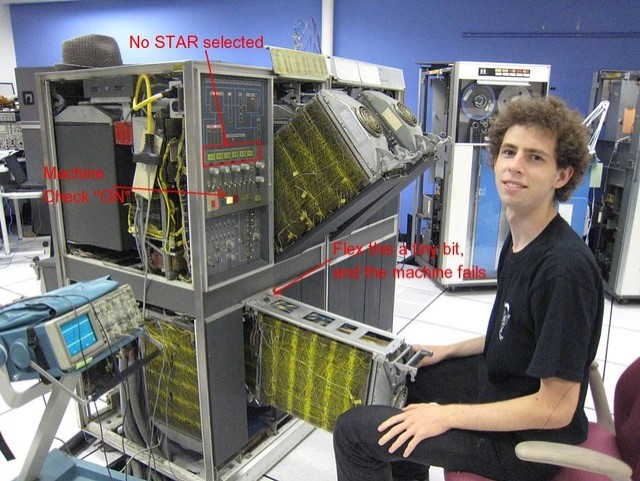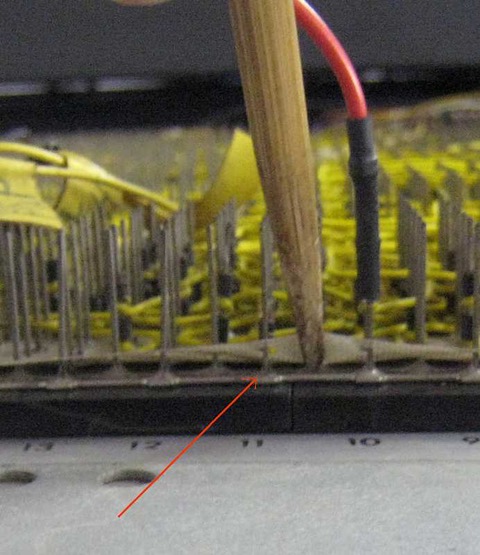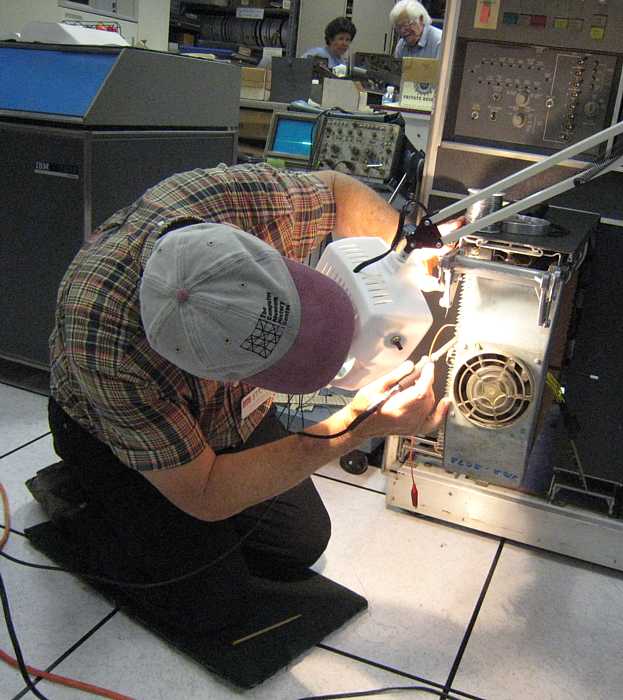Wire Wraped Backplanes, reliability
Background:
- What is wire wrap? Wire Wrap Is alive And Well! from "Nuts and Volts" magazine
- Bitsavers has an on-line manual "Programming the Gardner-Denver Automatic Wire-Wrap(R) Machine" showing the IBM 026 key punch as a wiring data input device. These and similar machines were widely used to wire computer backplanes.
"From small conversations, mighty topics grow".
small conversations
Re: AT&T Archives: A 20-year History of Antiballistic Missile SystemsGrowing ;--))
Wire wrapped connections were more reliable than soldered connections.Iggy Menendez sent
Thursday, November 11, 2021 4:29 PM sent Ed Thelen a URL from AT&T Archives knowing that Ed had maintained Nike Ajax equipment in the mid 1950s.
Ed Thelen replied
Thursday, November 11, 2021 6:54 PM At 8:50 minutes, the film says that wire wrap is more reliable than soldered backplane.
I had not even thought about that - ???The GE-225 computers that I maintained had GardnerDenver wire wrapped backplanes, with no failed wire-wraps while I was with them.
And I never heard of others complaining about them either."Our" IBM 1401s at CHM have wire-wrapped backplanes. [the things you stick "circuit cards" into.]
CCed were Robert Garner, Marc Verdiell, Ken Shirriff and Frank King
Iggy responded to all above
Thu 11/11/2021 9:06 PM
Ed,
"IBM told us that the wire wrap creates a ‘gas tight’ connection at four points on each turn.
I think I have seen in my life more failures from bad solder than wire wrap connections."
Iggy
Re: Reliability of wire-wrap -- also proven by our 60-year-old 1401s
E-mails (in time sequence) from Robert Garner, Lyle Bickley, Marc Verdiell, Allen Palmer, Dag Spicer, Grant Saviers, Gordon BellRobert Garner responded (to a much larger CC list) as follows:
Fri 11/12/2021 11:31 AM
Another data point is our 60 and 57-year-old 1401s(!):
To my knowledge, we have never had a problem with a wire-wrap (backplane) connection in them!But we did have one problem with a bad solder joint (that was bonding a wire-wrap pin to a backplane power trace, see below):
Searching our 1401 website, here’s an interesting note from John Van Gardner about IBM's wire-wrap backplane test machine:
../Sched2007December.html#05 {down 1 e-mail, Nov 31, 2007}
In another e-mail, John mentioned
It was a lot easier and cheaper to let the Gardner-Denver put the wires in when the board was manufactured. This was a big help in reducing field installation time.I used to watch them wrap boards in Poughkeepsie. These machines had 2 wrap heads and 2 positioning pins all under control of servos. There was a reel of yellow wire about 3 feet in diameter and 18 inches wide feeding into the machine. It would strip the wire on both ends and the positioning pins would go down over the via pins bending the wire there and wrap heads would wrap the to and from pins. It was very fast and hard to really see what was going on. This machine wrapped one end of the wire in a clockwise direction and the other end was counter-clockwise. We had a manual unwrap tool in our tool bag that one end was for unwrapping clockwise and the other end for counter-clockwise. We could tell if a wire was put on at the factory as all our field tools wrapped clockwise.
They had a 1401 connected to a special built machine that looked like a pizza oven. The board was place in it with the pins up and a contact panel lowered to contact each spring loaded pin. The 1401 would put a voltage on a pin and scan all the others to see where it went. This would detect opens and shorts. It didn't take the 1401 long to scan every pin in the board. If any errors were found they were printed out on a B1 typewriter. There was a woman there that corrected any mistakes. If she made more than 3 corrections the board had to go through the pizza oven again.
To my knowledge, we’ve never had any problems with the backplane wiring nor wiring harness (thank goodness!).
But we did have one backplane solder joint problem, 1st described by Ron Williams, on July 11, 2007: ../Sched2007July.html
“There is a temporary "short/open" in/near the 01B2 gate - Ron figures the cable/paddle area. The symptom is that when you run diagnostic tests and physically rotate the gate (even just a little), the diagnostic test will do unexpected things. Normal vibration and manipulating the cabling doesn't cause a problem."And elaborated here, on July 14 …"Ron Williams introduced Matthais to our current worry - If gate 01B2 (see Wed July 11) is more than half way open, then the handle lifted vertically just 1 cm - any program (even a branch to itself) running in the 1401 will halt in an illegal state - no Storage Address Register (STAR) is selected and the memory fetch is invalid - causing a Machine Check."… followed up with a photo of Matthais Goerner investigating:
"going after the problem. "We" were aware that relaxing the support rods would cause the problem, but Matthais started to worry about the hinge area where the wires were routed into the gate. There is considerable stress/flexture at this hinge.” 
clickThe problem was found / fixed on July 18 by Ron Williams, caused by a bad solder joint bonding a wire-wrap pin to (I presume) a power trace:
Cheers,
Probe now on pin 10 
clickWe decided that to solve the immediate problem, "we" would re-solder the defective pin. Here is Ron, on his prayer rug. making sure the job is done right this time !!! 
click- Robert
Lyle Bickley responded to all
Fri 11/12/2021 All PDP-1's are hand soldered with point to point wiring! When we were restoring the CHM's PDP-1, we found four cold soldered joints. We only repaired the one which affected the system's operation. The others were for I/O devices that were "prewired", but which our PDP-1 does not have.
We have never had a issue with a soldered connection since.
DEC, as IBM, moved to Gardener/Denver wire wrap machines for all their later systems. I don't remember any DEC system I was in contact with ever having a back plane wire wrap failure. (Although I have seen failures on both IBM and DEC systems when "patches" were made by CEs/FEs).
Cheers,
Lylehttp://bickeywest.com
"Black holes are where God is dividing by zero"Marc Verdiell wrote
Fri 11/12/2021 12:18 PM The Apollo Guidance Computer has a wire wrapped backplane, and nickel-welded component and wire connections in the modules. No soldering. They had found soldering not reliable enough in previous trials. This might have to do with soldering methods available at the time.
Marc
Allen Palmer wrote
Fri 11/12/2021 3:15 PM IBM was very concerned about the integrity of each wire wrap and that it not be ‘broken’ by movement ( breaking the seal where the post cut into the wire as it was warped around the 4 edges of the post on each wrap around the post) .
When installing EC changes ( changes to the wiring on the back panel for some update/correction/etc). A pin could have as many as 3 levels of wraps on it and if you need to replace the middle or lowest wrap and add a new wrap on that ‘post’ we forbidden from ‘pushing down’ the remaining (those still on the post) to make room to add the new wrap.
You would need to remove to those wraps sitting on top of the one for the EC change and follow it to the other end of it and remove that whole extra wire and replace the old with new wire ( you could not re-wrap a wire end once had been removed.
This meant in the design of the original wire layout IBM made sure that the wire linkage patten only maxed out at 3 links other wise you could be following an endless series if middle or lowest wraps.
Sometimes having to unwrap & rewrap wires could take as long or longer than those that were the EC change.. Truth be told, some guys used to ‘push’ down and move on but it was strictly a No No and hell to pay if you got catch doing it.
Allen Palmer
Dag Spicer wrote
Fri 11/12/2021 4:53 PM The US military studied this extensively many decades ago, in the context of the space program; no question – WW is absolutely more reliable than solder joints. It’s the ability to handle extreme environmental contexts like large temperature swings, shock, and vibration where WW shines. More importantly, the wrapping process itself applies tons of force per square inch on each joint, “nearly cold welding the wire to the post.”
Grant and Gordon: you’ve both run giant assembly lines – your thoughts? My understanding is that the GD WW machine was the sine qua non of the PDP-8 coming in at its remarkable ca. $25K price point.
Dag
-----
Dag Spicer Senior Curator Computer History Museum Editorial Board, IEEE Annals of the History of Computing 1401 N. Shoreline Blvd. Mountain View CA 94043 Tel: +1 650 810 1035 Revolution: The First 2000 Years of Computing Visit online! http://www.computerhistory.org/revolution/Grant Saviers wrote
Fri 11/12/2021 8:23 PM some comments, as I recall the DEC history:
The DEC R, S, & B module series were the building blocks for Classic 8, KA10, & PDP-9 using single side PCB connectors (another comment about these). The wire wrap for these was usually done by the Gardner Denver machine and the routing and optimization was on a PDP-6 or 10. I think one of the 10 engineers wrote the program, perhaps Gordon knows. The wire was about 24ga solid tinned copper, TFE insulation. TFE is great for feeding since it is so slippery, but it easily cold flows so careful routing is necessary so a wire doesn't cut thru on an unintended post. Yes, the corners of the posts must be sharp (very tight specs on that) and the wrapping tension correct to generate the cold welded gas tight connection. I'm a bit fuzzy on this but think the GD machine was punch card driven and would guess that was replaced with something more reliable at DEC.
Successive PDP generations used contacts on both sides of the PCB with the same PCB geometry and a 0.025" sq WW pin, so the pin grid was twice as dense. Now the pins were much more flexible and subject to bending and manufacturing tolerances. In spite of efforts to get pin tips exactly on position for the GD there were problems and GD machine crashes (often spectacular to clear) were a constant problem. The wire was now 28 or 30ga solid tinned copper and by this time TFE was replaced with more cut resistant insulation, usually Kynar. Also the thinner wire was harder to keep down in the pin grid alleys. Aside: WL Gore made much of the TFE wire, since a lot of that went away, they invented Gore-Tex.
With the GD problems creating a huge production bottleneck, DEC's chief Manufacturing Engineer, Tom Stockbrand (also LINCtape/DECtape Tom) took on the task of making "semi-automatic" wire wrap machines. These were servo controlled vertical frames to hold backplanes of various sizes. A PDP-8 would position a fixed WW gun tip guide at the start pin and guide the routing to the destination pin. The operator (mostly women) would wire wrap the start, enable the routing and wire wrap the destination. A bin on the side of the machine had tubes holding pre cut and stripped wire of all needed lengths and a light would identify which wire was to be used.
Tom got a few dozen of the machines built and the production bottleneck was resolved. The frames were heavy and Tom used hydraulic stepper motors for the XY positioning, and one day explained to me how they worked - very clever.
Re connectors: if you compare a DEC PDP-8 WW connector to an IBM 1401 they are identical except for the number of pins. IIRC, Sylvania made them for both companies. They are super reliable since a dot of gold wire is the contact, they aren't plated. I don't know who invented this but thanks for a super reliable connector.
One more aside: Bob Feretich and I designed and built the "TAU emulator" which simulates 729 tape drives for the 1401 restoration. My part was the analog simulator and Bob did the logic and programming. I offered anybody on the 1401 team a dollar a wire to wrap the 600 or so wires on my board and there were no takers.
Another comment about wire routing: I wrote an board placement optimizer (ie wire length minimizer) for my projects at the Case computing center (didn't every new logic engineer do this?). One important trick is to not change level on the start and destination pins for a wire. This leads to ECO's have to strip out the entire runs. Every wire needs to go L1 to L1, L2 to L2, L3 to L3. Then ECO's are much simpler to install.
There is an error in the CHM "DEC's Blockbuster, the PDP-8" I never saw one of these micro WW machines on the manufacturing floor. The DEC GD was a large (6' x 8' per wikipedia) one capable of entire PDP-9 and 10 backplanes - 19" x 50" or so and wrapped 22/24 ga wire on rectangular pins.
Also, the "Wire Wrap" wikipedia entry is incorrect on the PDP-8/I panel picture caption. It was wrapped on one of Tom's semi-automatic machines.
I'm sure more than anybody wants to know ;).
See also Tom's oral history which Gardner and I took pre covid. I've copied Tom so he can correct me (which he often did at DEC) ;).
regards,
Grant
Sun 11/14/2021 3:25 PM All
Just endorsing Gran's discussion and amplifying its importance especially on the industry formation in Massachusetts. The price PDP 8 with Teletype ASR was 18K. Wire Wrap was the key to cost and especially the ability to manufacture 8's in volume. Interestingly, the problem of time and errors n manual wiring in building the PDP-6 was the initial impetus for Wire Wrap.Massachusetts Minicomputers...technology was at the root
g
- DEC was started in 1957 based on transistor circuits that the founders designed at MIT's Lincoln Lab
- Wire Wrap is one of the factors that affected the outcome of the DEC - 3C (Computer Control Corp in themed 60s.
- Word length and cost, ana 3C 16 bit intro that Gardner designed were a factor
- Transition from discrete transistor to SSI opened up an opportunity.
- Fortunately for DEC, the 3C Founders cashed out by selling 3C to Honeywell...
- and then in 1969
- Ed DeCastro and Henry Burkhardt left DEC to form DG, exploit MSI, and use one large board to hold a single processor.
- With SSI and MSI anyone who wanted to build a mini computer started a company and roughly 91 did
